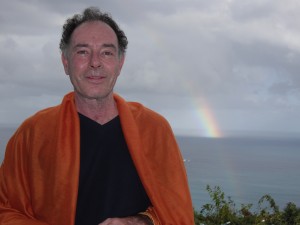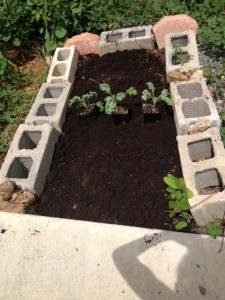 Driving across the island enjoying the after glow of one of the best smoothies I’d ever made, I reviewed, in my mind, the tasty, healthful ingredients that had gone into its creation. There was the papaya I had just picked, a lime and a star fruit from my trees, cocoanut water from Clement the Magen’s Bay Coconut man, hemp powder for a major dose of protein and fig bananas and kale from the rasta farmer at the Bordeaux market.
Driving across the island enjoying the after glow of one of the best smoothies I’d ever made, I reviewed, in my mind, the tasty, healthful ingredients that had gone into its creation. There was the papaya I had just picked, a lime and a star fruit from my trees, cocoanut water from Clement the Magen’s Bay Coconut man, hemp powder for a major dose of protein and fig bananas and kale from the rasta farmer at the Bordeaux market.
When I thought of the kale I was reminded of my desire to plant my own crop and how I get stymied by my need for enough soil to fill up the 9’x4’ plot I’ve surrounded with cinder blocks. Even though I drive around with two buckets and a shovel in the back of my car and have been told where there are piles for the taking, I’m not always dressed for the task or in the mood to stop and shovel and, the one time I did, I felt discouraged at how two buckets of soil didn’t go very far.
When I realized that I could divide the plot into a smaller chunk, a light bulb went off in my brain. Combined with the potting soil I have on hand and the results of my new compost pile – I’d be ready for seedlings in no time and could look forward to adding my own kale to my smoothies – a thought that made me smile. I felt liberated and wondered why it had I taken me so long to figure out that a chunk would get me going and had languished in the land of overwhelm and not enough instead? I knew too that this is familiar territory extends beyond the boundaries of my nascent garden into other areas of my life in the land of unfinished business, works in progress and drippings from the good stuff of life that is waiting to be turned into gravy or something equally delicious.
I have dreams and lots of them. Many have come true thanks to my efforts, lots of help from my friends and family and the amazing ways the universe has of conspiring on my behalf. But there are lots that are waiting in the wings – some just needing a coat of paint while others have so many steps involved in their conception and birth process that when I think of all that is involved in getting from here to there my brain fogs over and I put them on the back burner or the endless to do list where they sit and clog up the works and, like plaque, prevent the free flow of unimpeded energy.
The Place mat process of Abraham is great for dealing with overwhelm. It involves taking a few top priority items from your endless to do list and putting them in a column under your name while putting the rest of the list in a column labeled The Universe. It’s a way of cutting what’s on your plate into manageable bites and a vote of confidence that the universe, God, source, the powers that be, are also taking care of business.
Time management experts suggest breaking tasks into small increments and production lines include descriptions of every extension and exertion involved in a particular task. I’ve been working with a coaching program whose challenge is to break things down into their smallest components, to be specific and set clear deadlines. It’s not good enough to say “make healthy soups twice a week”. I’m asked to specify whether I have the necessary recipes and ingredients and if not when so life is easy and I don’t get sidelined with no recipe and no potatoes for the vichychoisse for example.
If you are going to start an exercise program that involves running or swimming – do you have sneakers or goggles and if not when are you going to get them? If you want to earn 5,000 this month from your sales job – how much do you have to bring in today, how many sales calls to have as many conversations as you need to get your target number of buyers. Nothing vague or fuzzy here.
My plot of Kale is pure poetry and a metaphor for the rest of my life where focusing on a smaller more manageable chunk of my garden plot means I can fill it up sooner than later and add my home grown kale to my home grown smoothie – a testimony to the benefit of, what I’m calling, “Chunky Living” where we stay present, bite off what we can chew and reap the benefits of being here now.
Lately, on my morning beach walks, I’ve been playing with shifting my gaze. – Throwing it way out like a yoyo to take in the big picture, all the way to the end of the creseent that is Magen’s Bay, and then slowly reeling it in and enjoying the scenery along the way, until I’m finally looking straight down at my feet.
There’s a spot where my gaze is most comfortable. It’s where my eyes, neck and head are in their ‘rest’ position and it’s approximately 12 feet ahead.
When I look to the end of the beach I can see the big picture and people and objects in the distance are small and indistinct. As I bring my gaze in closer everything becomes bigger and clearer until, up close and personal, things are super-sized and fill up my field of vision like my giant big toe.
12 feet ahead provides the perfect little world in which to walk. It includes the footsteps of those who’ve gone before, the sand, any obstacles, jelly fish, sea gulls, sand crabs, a peripheral view of the sea, approaching people and a peaceful, private inner place.
The word Drishti came to mind when I was walking. It’s a Sanskrit word that refers to where to place your gaze in each yoga posture so, when I got home I got down David Swenson’s Ashtanga Yoga Practice Manuel and sure enough, what I’d been doing was experimenting with my drishti – looking for the perfect balance between my inner and outer worlds – my beach walking Drishti.
Each asana (yoga posture) has a Drishti associated with it – a suggested place to focus your gaze that enhances the benefits of each posture – like increasing your stretch by leading it with your gaze or deepening a bend by gazing at your big toe. In Yoga the Drishti also refers to an internal gaze and inner awareness that like a microscope reveals what we may not see externally.
As there is a Drishti associated with each yoga posture, for our outer and inner benefit, I’m seeing that there’s a Drishti associated with all our movements whether we are walking on the beach, washing dishes, having a conversation, sitting at our desks, doing pirouettes, reading a book, driving a car etc.… an ideal positioning of the body, head and gaze that is comfortable, ergonomic, expends the least effort and helps us to be present and focused on what is immediately before us and immediately within us.
I used this notion of Drishti (conscious focus) with great results when walking on the Camino de Santiago in France several years ago. My companion forged ahead on the steeper hills, leaving me, slow and steady, in the dust. When the going was steep and long, I found that if I l kept looking ahead, I got discouraged but if I looked up at the beginning to take stock and then kept my gaze (Drishti) about 12 feet ahead of me, staying in the present in my mind and with my gaze, I enjoyed the journey and celebrated summits. It worked downhill too with me in the lead leaping ahead like a goat.
I learned that it’s good to have a destination and then not to get too far ahead of yourself en route.
The same thing holds true for paddle boarding. If I’m la di dahing around out there scanning the horizon looking for turtles and dreaming of dolphins my gaze ranges far and wide but when I’m determined into the wind and mustering strength to move the board through the water, I focus on the water just in front of the board (probably about 12 feet ahead), gauge my speed and cultivate momentum.
In Buddhist meditation, you are encouraged to mediate with your eyes half open and your gaze cast downward and in front of you – a Drishti to enhance the purpose of the practice – being fully present.
The message I’m getting is that once we know where we are going, we’d do best to return to a manageable chunk of the present. Keeping our focus on what’s in the here and now will enhance whatever we are doing inside and out.
Like all yogic practices, Drishti uses the gifts of a human body and mind as a starting place for connecting to our full potential.. When we clear our vision of the veil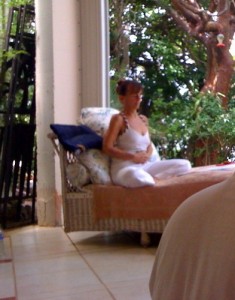 of habits, opinions, ideas, and their projections about what is real and what is false, we gaze beyond outer differences toward the absolute Truth.
of habits, opinions, ideas, and their projections about what is real and what is false, we gaze beyond outer differences toward the absolute Truth.
May we all cultivate the ideal drishti – or perfect gaze for whatever we are up to today and always.
Healing
1. To restore to health or soundness
2. To set right; repair
3. To restore (a person) to spiritual wholeness.
Healing comes in all shapes and sizes, seen and unseen and contrary to what we are often told by doctors, therapists, gurus, ministers and healers of all sorts – no one has a monopoly on making whole what feels broken or restoring health of body, mind or spirit to dis ease. There’s room for a smorgasbord of approaches to healing – sound healing, Chakra clearing, talk therapy, hands on healing, massage, jin sinjitsu, energy work, yoga, herbs, aroma therapy, B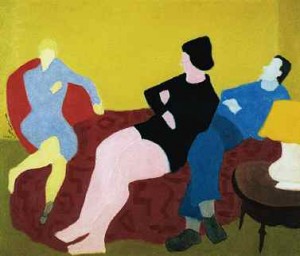 ach flower remedies, western medicine, eastern medicine, spiritual counsel, laughter therapy and hugs all around. There is so much available to us in the outside world and our inner terrain to helps us feel better and remind us that our natural state is 100 percent wholeness or health.
ach flower remedies, western medicine, eastern medicine, spiritual counsel, laughter therapy and hugs all around. There is so much available to us in the outside world and our inner terrain to helps us feel better and remind us that our natural state is 100 percent wholeness or health.
Which is why it was so gratifying when one of my client’s showed up at her session, plopped down and said, “I feel whole”. What more could a healer ask.
While I specialize in talk therapy and life coaching – an approach to healing that uses words to point to and elicit feelings, asks questions which shift focus and open gateways to new perspectives and uses words as as archeological tools to unearth buried pain and buried treasure (often the same thing), I am a big proponent of mixing it up and of whatever works.
One client shared that part of her healing had involved getting an answering machine to screen her calls, listening to music that told her story and inspired her and another credited regular exercise, changing his diet and working with an expert in chakra balancing for his new found well-being. I’ve encouraged clients to turn warring parts of themselves into puppets so that they can bridge the gap and cultivate compassion and understanding and move toward unity, collaboration and one love wholeness. I suggest that they look around see themselves in their or others’ children imagining themselves at the age where something happened, something got stuck and some part of them froze.
Every person, place and thing we encounter has the capacity to be a touchstone, a healing amulet, a magic potion. I ask questions and see what my crystal pendulum has to say, people read palms and tarot cards, and decipher their messages, my grandmother read tea leaves, my doctor listens to my heart with his stethoscope and Jesus had the ability to restore life to dead and sight to the blind.
Marianne Williamson reminds us that every encounter is a holy encounter so that even as we may want to turn away in disdain or like a casting director call NEXT – healing medicine is always being offered if we are receptive to the lesson, the antidote and the challenge to see beyond the surface into the depths.
A little blue book called Heal your life by Louise Hay fell into my life many years ago when I was holed up in my apartment in New York with a bad back. I suffered from severe pain shooting down my left leg and was unable to walk any further than from one side of my studio apartment to the other. When I looked up Back, it said that the back represents feeling supported by support of life and that the lower back represents fear of money lack of financial support. The affirmation that is the antidote to this mental patters is: I know that life always supports me and I trust the process of life. All I need is always taken care of. I am safe.
I wrote these affirmations on post-its and plastered them around my tiny apartment and, to this day, whenever my back bothers me I remind myself that I am always supported, that I am safe and that I trust the process of life.
We are all healers. We have the ability to heal our own lives if we remember that we are each responsible for all of our experiences, that every thought we think is creating our future and that the point of power is always in the present moment. If we are willing to release resentment, criticism and guilt and forgive ourselves and others we free ourselves from damaging patterns, dissolve emotional and physical illness and last but not least when we really love ourselves, everything in our lives works.
We also have the power to heal others whether or not we call ourselves healers or practice the healing arts professionally. Our unconditionally loving presence is healing to others, a hug is healing. Seeing the best and encouraging one another is healing and there is great power of healing in a loving touch.
I attended a talk last night where the speaker shared that her spiritual and personal growth had more to do with remembering than with learning anything new and it struck me that healing has more to do with remembering than with fixing – that, as was repeated over and over in my coaching courses, everyone is whole and complete, no one needs to be fixed, we all have our own answers – It’s just a matter or helping people (and ourselves) remember this truth and like, Orpheus leading Euridyce from the depths –once we turn on the light of consciousness and compassion what has been hidden in the darkness of our underworld will set us free and restore us to wholeness.
Many years ago, when I lived in Montreal, I loved wandering around at beginning of spring, delighting in the little gardens sprouting in the small urban front yards of brownstones where outdoor wrought iron staircases spiraling up to second and third stories. Bowled over by the charm, creativity and love that went into the arrangements of colorful bulbs, newly planted tomatoes and garden props (flamingos, elves and saints), I dreamed of creating a book that would be called Les Petit Jardins de Montreal (the little gardens of Montreal). It would be printed by Vehicule Press, the print shop that I ran back then and it would open to full page photos of each little garden. On the facing page I saw a photo of the gardeners (Madame, Monsieur and family) with a short bio and description of their garden.
Today I am wandering around Montreal and thinking the same thought as I see tulips waving their colorful heads, daffodils beaming like sunshine, painted butterflies hanging in trees and lilys pushing their way through the newly thawed earth. The grapevines on my friend’s deck are getting greener everyday and the misshapen branches of winter trees are misty with the promise of golden flowers and green leaves. It’s a new beginning and everyone is celebrating. People are spilling out into the streets, sitting in cafes, coaxing their winter weary lawn mowers into action, riding bikes, trading boots for sandals and flopping down in parks and on balconies to soak up the rays. It’s a truly glorious time of year that we, in the tropics forget as we luxuriate in year round lushness.
My visit is a bittersweet one. I came to see a long time best friend who was diagnosed with pancreatic cancer less than two months ago. His rapid decline and recent hospitalization made me book my ticket sooner than later. I arrived in Montreal last Tues. evening, took a cab from the airport to the hospital and got to see him, hold his hand, rub his back and tell him how much I love him. He died early the next morning. Though I knew what was coming I’d hoped for more time and along with many other friends and family, I was devastated. I’ve been cleaning his house, helping plan his funeral and wandering the city thinking of him.
Martin Kevan is the first person in our extended group of friends who met in the late 60’s to leave this earth – not the first loss I have known – but different somehow. Perhaps it’s the shockingly short time between his diagnosis and death. Maybe it’s because we’re at or approaching the age when people start to check out and, it’s a wake up call, a reminder of our powerlessness, and an in your face reminder that we are all going to die no matter what we do. Like Dick Solberg, the Sun Mountain Fiddler sings – “you can become a vegan and you’re still going to die, you can stop smoking cigarettes and you’re still going to die etc… etc…”
I’ve lost a best friend who I’ve have known since I was 21. We have accompanied one another through all the chapters of our lives – in person, via letters, phone calls and emails and we each have photos in our jumbled box of pictures to prove it. There’s us looking dewy, young and innocent in the late 60’s, my daughter riding on his back in the sea at Hull Bay when he visited and riding a roller coaster at Man and His World (the leftover amusement park of the Montreal world’s fair) a few years later, the two of us eating un petit cornet en vanille enrobe en chocolate avec des bon bons (small vanilla soft ice cream cones dipped in chocolate with sprinkles), groups of us on roof tops in NYC, in London, Montreal and the Virgin Islands: a lifetime of deep connection and great love.
An accomplished actor of stage and screen, a published author, a teacher of writing and theatre arts, Martin was most recently excited about his highly successful debut in the world of video games – as Dr. Earnhart in the wildly successful UbiSoft game Far Cry 3. He was also a gardener and as I sit in his house, missing him I’m looking out on his little garden and smiling at the recent arrival of daffodils, tulips, crocuses and the lilies of his own petit jardin de Montreal – one that he missed seeing this year but that will figure largely in my yet to be born book.
Gardens are some of my best teachers as I come to terms with the circle of life. It’s so clear and natural that flowers bloom and die, that seeds sprout, flower, bear fruit and start all over again. We all put down roots and are nourished both from below and from above seeding and fertilizing the soil that we came from and, hopefully, leaving it richer for our having been here.
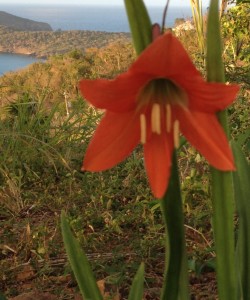 The laughing gulls are back in town. Lined up on every available boat they didn’t know whether to be afraid or stay put as I silently paddled by at Magen’s Bay this morning, welcoming them home and delighting in their convivial jostling and raucous disturbing of the peace. According to a reliable source, they show up in time for Carnival and leave at Halloween- reverse snow birds who arrive in April, the month of taxes and now of the devastating explosions at the Boston Marathon.
The laughing gulls are back in town. Lined up on every available boat they didn’t know whether to be afraid or stay put as I silently paddled by at Magen’s Bay this morning, welcoming them home and delighting in their convivial jostling and raucous disturbing of the peace. According to a reliable source, they show up in time for Carnival and leave at Halloween- reverse snow birds who arrive in April, the month of taxes and now of the devastating explosions at the Boston Marathon.
Walt Whitman mourned the assassination of President Abraham Lincoln in a poem that I remember my father reciting when I was a child:
When lilacs last in the dooryard bloom’d
And the great star early drooped in the Western sky,
I mourned and yet shall mourn with ever returning spring
TS Eliot, tipping his hat to his poetic ancestor, begins his signature modernist poem The Wasteland with a section called The Burial of the Dead:
April is the cruelest month, breeding
Lilacs out of the dead land, mixing
Memory and desire, stirring
Dull roots with spring rain. –
It all happens at once – the lilacs (or here the lilies), the laughing gulls, spring –– sweet smelling, happy sounding, natural events that return no matter what like the planets in their orbits – oblivious to whether we are celebrating or beating our breasts.
I chant when I paddle and this morning the words were especially poignant:
O Peace Deep and Divine, enter this heart mine.
O Peace sweet and sublime, enter this heart of thine.
Om Shanti, Shanti, Shanti, (Peace Peace Peace)
As I sang, images of the wounded, the bloody sidewalks, the ambulances and the crowds flashed before me and I felt powerless – flooded by fear, anger, anguish, hatred, revenge, by lives changed forever in an instant, hopes dashed, families torn apart and marathons taking on new meaning from here on in. I recalled a story that a friend posted on FB a while back and it gave me something to focus on and perhaps it will do the same for you.
There was a car accident on the freeway – a major commuter route and in the accident a woman was critically injured. She had to be removed from her crumpled car by the jaws of life and taken by helicpoter to a major medical center in critical condition. Traffic was backed up for miles and the radio reported an injury accident and warned of delays. People were aggravated. Eager to get home after a long day at work, they grumbled as they called spouses and day car centers to say they’d be late. There was lots of complaining and moaning and groaning and impatience mounted.
One woman (and maybe there were more) in a car not far away closed her eyes and sent healing love and light to the injured woman though she didn’t know that it was a woman or if she was alive or dead. She just automatically sunk down into her heart and tapped into a stream of golden light that she let it flow from her heart to the injured passenger. According to the story, the woman survived her injuries and eventually made a fully recovery.
In a newspaper interview she said that while she was lying there in a near death state she was aware that there was someone who was sending her light and that she truly believed that that light had kept her alive.
I’d like to add that the two met, that the injured woman had the chance to share her experience and to say thank you and that the streamer of light got to behold the results of her love and light but I would be making that up….
What I do know is that while I was paddling that’s what I decided to do. I pictured my heart opening and steady stream of golden light making its way to the hospital rooms where the injured lie, to the homes where families are crying and grieving and runners are still shaking in gratitude and in fear. I sent it into the hearts and minds of everyone who is angry and afraid and full of hatred, including the perpetrator. I pictured a hose as thick and as sturdy as a fire hose but larger and more powerful and, as I sang my peace chant, I directed that hose far and wide with the sound of the gulls laughing raucously in the background as they swooped and dove into a sea, turquoise and alive with fish.
